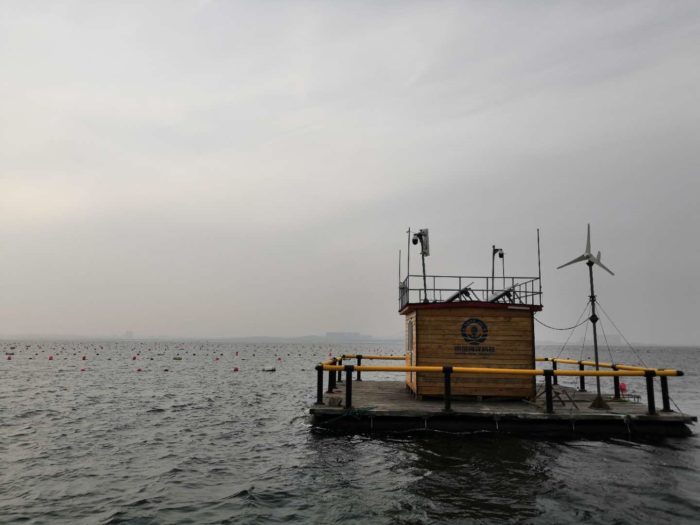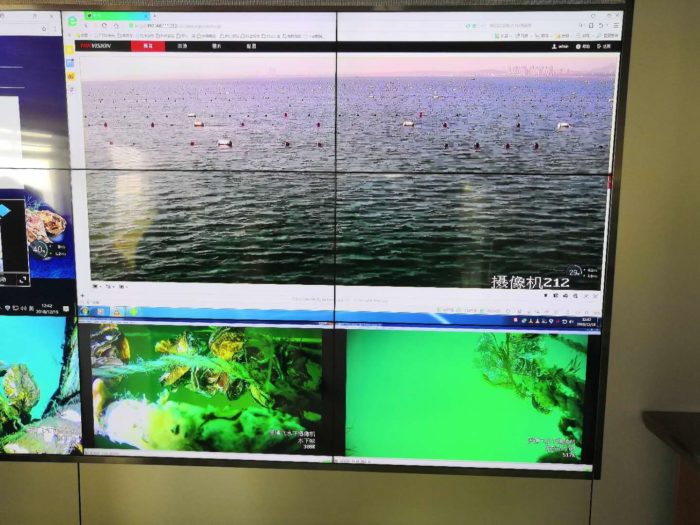Key points about this IMTA site in China
- Type of site: Bay-scale commercial IMTA site
- Location: Sanggou Bay, Shandong province, China
- Type of aquaculture production: Coastal aquaculture
- Provided by: YSFRI – Yellow Sea Fisheries Research Institute, Chinese Academy of Fishery Science
Take a look at some footage from the site!
Interview
- Interviewee: Zengjie Jiang, Research Professor, Yellow Sea Fisheries Research Institute, CAFS
- About YSFRI coastal aquaculture site, can you tell us about its size and production?
- ZJ: The aquaculture site of YSFRI is located at Sanggou Bay, Rongcheng city, which is at the east end of the Shandong Peninsula, China. The local aquaculture industry operates the pilot, and among them, Chudao Aquatic Food Co., Ltd is our collaborator for the IMPAQT project. The area of the bay is 140^2km, and nearly two-thirds of it are used for the long-line aquaculture of kelp Saccharina japonica or Pacific oysters Crassostrea gigas. From the previous statistics, the production of kelp and oysters are 84,500 tons (dry weight) and 60,000 tons (wet weight), respectively.
The area of the bay is 140^2km , and nearly two-thirds of it are used for the long-line aquaculture of kelp Saccharina japonica or Pacific oysters Crassostrea gigas. From the previous statistics, the production of kelp and oysters are 84,500 tons (dry weight) and 60,000 tons (wet weight), respectively.
2. About YSRI coastal aquaculture site, can you tell us about its size and production?
- ZJ: The current aquaculture practice regarding IMTA in Sanggou Bay is the integrated aquaculture of kelp and oysters with the long-line method, as mentioned above, and some sea cucumber on the sea bed. The aquaculture of kelp usually starts in November and harvest begins the following April, until August. For oysters and sea cucumber, they are cultured all year round and harvested depends on the season and market demand.

3. What are the current practices regarding IMTA that you carry out in this site?
- ZJ: The current aquaculture practice regarding IMTA in Sanggou Bay is the integrated aquaculture of kelp and oysters with the long-line method, as mentioned above, and some sea cucumber on the sea bed. The aquaculture of kelp usually starts in November and harvest starts the next Aprile until August. For oysters and sea cucumber, they are cultured all year round and harvested depends on the season and market demand.
The aquaculture of kelp usually starts in November and harvest starts the next Aprile until August. For oysters and sea cucumber, they are cultured all year round and harvested depends on the season and market demand.
4. Why is China such as reference for IMTA? What can Europe learn from China´s approach to IMTA?
- ZJ: China is one of the countries that have successfully operated the commercial-scale IMTA in the world. First, there is a market demand for food production from the aquaculture industry. People prefer diverse plates of seafood, which promotes the sector and develops many kinds of species with different trophic levels. Second, IMTA benefits the farmers both in sea usage and economic income. Third, there is a request for sustainability because of environmental pollution problems in China and also other places in the world. The government needs ecological aquaculture to get economic and social development. IMTA is a proper method to satisfy the social-economic request and, in the meantime, to ease the environmental pressure. As being introduced by Jianguang Fang since the 1990s, the integrated multi-tropic aquaculture has been practiced for more than 20 years, and it turned out to be effective.For the development of IMTA in the EU, we believe it is essential to adapt the IMTA theory to the local practice according to geographical, environmental, and social-economical conditions. The current commercial-scale IMTA in China is an accumulation of decades of practical experience adapting to hydrology, material/nutrient cycle, organism physiology, and the regulation & policies locally. The expertise of IMTA in China can be a reference for the EU to develop the local version as technical storage for further sustainable development requests, and to deal with global climate change situations.
IMTA benefits the farmers both in sea usage and economic income. there is a request for sustainability because of environmental pollution problems in China.
For the development of IMTA in the EU, we believe it is essential to adapt the IMTA theory to the local practice according to geographical, environmental, and social-economical conditions.
5. Is there regulation, funding Projects and other help from the government that helps the development of IMTA in China?
- ZJ: The researchers and farmers initiated the IMTA. Then there was funding from the nation to promote the IMTA technology development in the past decades. The funding helped to improve technology and modes. Until the beginning of 2019, there was a regulation from the nation as a suggestion to promote the development of sustainable aquaculture in the whole country, and IMTA was only a part of the many good methods.







